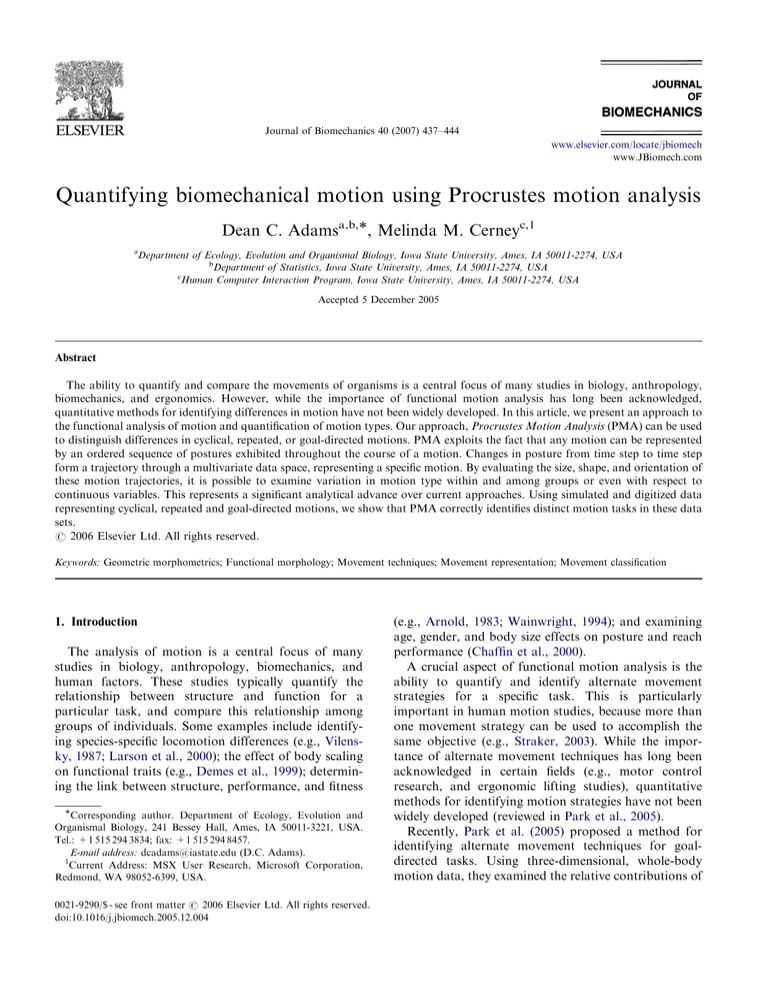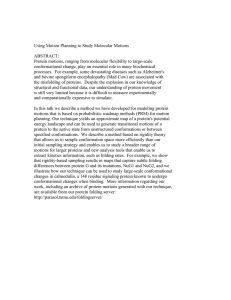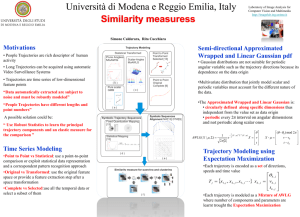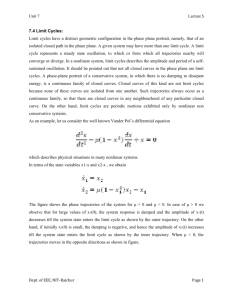
ARTICLE IN PRESS
Journal of Biomechanics 40 (2007) 437–444
www.elsevier.com/locate/jbiomech
www.JBiomech.com
Quantifying biomechanical motion using Procrustes motion analysis
Dean C. Adamsa,b,, Melinda M. Cerneyc,1
a
Department of Ecology, Evolution and Organismal Biology, Iowa State University, Ames, IA 50011-2274, USA
b
Department of Statistics, Iowa State University, Ames, IA 50011-2274, USA
c
Human Computer Interaction Program, Iowa State University, Ames, IA 50011-2274, USA
Accepted 5 December 2005
Abstract
The ability to quantify and compare the movements of organisms is a central focus of many studies in biology, anthropology,
biomechanics, and ergonomics. However, while the importance of functional motion analysis has long been acknowledged,
quantitative methods for identifying differences in motion have not been widely developed. In this article, we present an approach to
the functional analysis of motion and quantification of motion types. Our approach, Procrustes Motion Analysis (PMA) can be used
to distinguish differences in cyclical, repeated, or goal-directed motions. PMA exploits the fact that any motion can be represented
by an ordered sequence of postures exhibited throughout the course of a motion. Changes in posture from time step to time step
form a trajectory through a multivariate data space, representing a specific motion. By evaluating the size, shape, and orientation of
these motion trajectories, it is possible to examine variation in motion type within and among groups or even with respect to
continuous variables. This represents a significant analytical advance over current approaches. Using simulated and digitized data
representing cyclical, repeated and goal-directed motions, we show that PMA correctly identifies distinct motion tasks in these data
sets.
r 2006 Elsevier Ltd. All rights reserved.
Keywords: Geometric morphometrics; Functional morphology; Movement techniques; Movement representation; Movement classification
1. Introduction
The analysis of motion is a central focus of many
studies in biology, anthropology, biomechanics, and
human factors. These studies typically quantify the
relationship between structure and function for a
particular task, and compare this relationship among
groups of individuals. Some examples include identifying species-specific locomotion differences (e.g., Vilensky, 1987; Larson et al., 2000); the effect of body scaling
on functional traits (e.g., Demes et al., 1999); determining the link between structure, performance, and fitness
Corresponding author. Department of Ecology, Evolution and
Organismal Biology, 241 Bessey Hall, Ames, IA 50011-3221, USA.
Tel.: +1 515 294 3834; fax: +1 515 294 8457.
E-mail address: dcadams@iastate.edu (D.C. Adams).
1
Current Address: MSX User Research, Microsoft Corporation,
Redmond, WA 98052-6399, USA.
0021-9290/$ - see front matter r 2006 Elsevier Ltd. All rights reserved.
doi:10.1016/j.jbiomech.2005.12.004
(e.g., Arnold, 1983; Wainwright, 1994); and examining
age, gender, and body size effects on posture and reach
performance (Chaffin et al., 2000).
A crucial aspect of functional motion analysis is the
ability to quantify and identify alternate movement
strategies for a specific task. This is particularly
important in human motion studies, because more than
one movement strategy can be used to accomplish the
same objective (e.g., Straker, 2003). While the importance of alternate movement techniques has long been
acknowledged in certain fields (e.g., motor control
research, and ergonomic lifting studies), quantitative
methods for identifying motion strategies have not been
widely developed (reviewed in Park et al., 2005).
Recently, Park et al. (2005) proposed a method for
identifying alternate movement techniques for goaldirected tasks. Using three-dimensional, whole-body
motion data, they examined the relative contributions of
ARTICLE IN PRESS
438
D.C. Adams, M.M. Cerney / Journal of Biomechanics 40 (2007) 437–444
joint degrees of freedom and compared the utilization
patterns between tasks and individuals. While this
approach provides a quantitative means of identifying
human motion strategies, it is limited to the analysis of
goal-directed tasks. As a result, it cannot be used to
examine the full breadth of motion data exhibited by
humans and other organisms. For example, complex
motions such as running and jumping, and cyclic
motions such as swinging a golf club, are common in
functional morphological studies but cannot be quantified and identified using their approach (see Park et al.,
2005).
Because these motion types are of vital importance to
many biomechanical studies, it is critical that a general
approach to motion analysis is developed. In this study,
we present a general approach to the functional analysis
of motion and quantification of motion types that can
distinguish differences between cyclical, repeated, or
directed motions. The approach, Procrustes Motion
Analysis (PMA), exploits the fact that any motion can
be represented by an ordered sequence of postures
exhibited throughout the course of a motion. Changes in
posture from time step to time step form a trajectory
through a multivariate data space, which represents a
specific motion. By evaluating the size, shape, and
orientation of these motion trajectories, it is possible to
examine variation in motion type within and among
groups or with respect to continuous variables (e.g.,
motion relative to age). Below we describe the PMA
procedure, and demonstrate its ability to detect differences between distinct arm and body motions for both
simulated and captured motion data.
2. Methods
2.1. Motion trajectory quantification
Because motion is an ordered sequence of postures
through time, simply quantifying the posture at each
time step and identifying postural differences over time
accurately represents a motion. To quantify posture we
use geometric morphometric methods (Bookstein, 1991;
Adams et al., 2004). First, we record the x, y, z positions
of p anatomical landmarks on a set of individuals during
each time step of a motion or motions (for 3dimensional landmarks, more than 3 non-colinear
landmarks should be used). Landmarks typically identify underlying bony structures to estimate joint centers,
or are other anatomical features that represent the
overall shape of an individual (e.g., eyes, nose, etc.).
Each configuration of landmarks is then treated as a
p 3 matrix of coordinates and represents the posture of
an individual at a given time step during a motion, using
the landmark coordinates as variables (3p). Postures are
standardized for differences in scale, position, and
orientation by superimposing them through a Generalized Procrustes Analysis (GPA: Rohlf and Slice, 1990).
GPA centers each configuration at the origin, scales
each to unit-centroid size, and optimally rotates each
configuration so corresponding points align as closely as
is possible. After GPA superimposition, each standardized posture is represented as a point in a curved shape
space (of 3p-7 dimensions: Rohlf, 1996). To perform
standard multivariate analyses, these are then projected
into a linear tangent space that contains the same
number of dimensions, 3p-7 (i.e., projection, but not
dimension reduction: Rohlf, 1996, 1999). Thus, after
standardization and projection, each posture is represented by a set of 3p-7 shape variables in linear tangent
space, which are used to compare shape variation within
and among groups of individuals (e.g., Adams and
Rohlf, 2000; Adams, 2004).
A useful feature of geometric morphometrics is that
the shape variables quantitatively describe the position
of each individual in the multivariate tangent space. In
tangent space, similar configurations of points (corresponding to individuals in similar postures) are close
together. By capturing the same individual repeatedly
throughout a motion, a sequence of postures is
generated that corresponds to distinct points in tangent
space. Connecting this ordered sequence of postures
defines a trajectory through tangent space that describes
the path of a particular motion. A general schematic
representing this procedure is found in Fig. 1.
2.2. Statistical assessment of motion trajectories
The motion trajectories described above quantify how
posture changes throughout a motion. It is important to
recognize however that these trajectories can differ in a
number of ways. First, the manner in which posture
changes throughout a motion may differ between
motions (i.e., motion trajectories differ in shape).
Alternatively, two motions may have similar trajectory
shape, but the extent of one motion path may be greater
than that of another (i.e., motion trajectories differ in
size). Finally, two motions may differ in their orientation relative to the body (i.e., motion trajectories differ
in orientation). Our approach statistically examines all of
these components.
To extract the size, shape, and orientation parameters
for each trajectory, we perform a GPA superimposition
of the motion trajectories (Fig. 2). First, the shape
variables for each posture at each time step of an
individual motion are concatenated into a single vector
representing a trajectory. Trajectories are then standardized for position, size, and orientation through
Procrustes superimposition (see above). During this
superimposition, we retain the size and orientation
information for further analysis. The size of each
motion trajectory is calculated as centroid size: the
ARTICLE IN PRESS
D.C. Adams, M.M. Cerney / Journal of Biomechanics 40 (2007) 437–444
439
Fig. 1. A schematic diagram representing a sequence of postures digitized throughout a motion. After GPA superimposition, each posture
corresponds to a point in a multivariate data space (Note: actual data are in a data space of considerably higher dimension). A sequence of postures
quantitatively describes a trajectory through the space, which represents the motion. In this schematic example, two distinct arm-waving motions are
shown. Both motions begin and end at the same points (open circles), but the two motion trajectories differ (closed and hatched circles),
demonstrating that each is a distinct motion trajectory (Y1 and Y2).
5.5
5
4.5
4
3.5
3
2.5
2
1.5
1
0.5
0
4
1
3
GPA
Superimposition
2
1
2
3
4
5
6
Trajectories in two dimensions
of tangent space
0.4
0.3
0.2
0.1
1
0
-0.1
4
-0.2 3
2
-0.3
-0.4
-0.6 -0.4 -0.2 0 0.2 0.4 0.6
Aligned trajectories
+
Size
Orientation
1
2.408
(1, 0)
2
2.775
(1, 0)
3
3.782
(0.78, 0.63)
4
0.981
(0, 1)
Fig. 2. Trajectories are standardized for position, size, and orientation through Procrustes superimposition. Size and orientation information are
retained for further analysis.
square-root of the sum of squared distances between
postures and the trajectory centroid in the multivariate
space (Bookstein, 1991). The orientation of each
trajectory is described by the principal axis of the
trajectory data based on a principal components
analysis. The set of variables describing each trajectory
after superimposition define its shape (see Fig. 2).
Typically, a general linear model analysis (e.g.,
ANOVA) is performed to statistically compare groups.
Unfortunately, this is not possible when comparing
motion trajectories, because the high dimensionality of
trajectory shape information precludes the use of
standard designs due to lack of sufficient degrees of
freedom (because the number of landmarks the
number of time steps used to quantify motion trajectories typically exceeds the number of individuals). We
therefore used an alternative approach based on the
difference in values between trajectories. Our method
uses Mantel tests of matrix correlation (Mantel, 1967) to
evaluate the association between trajectory attributes
represented in a dissimilarity matrix and a hypothesis
(design) matrix. For trajectory shape, we calculated
the pairwise
Euclidean
distance between trajectories
qffiffiffiffiffiffiffiffiffiffiffiffiffiffiffiffiffiffiffiffiffi
ffi
(Dij ¼
ðY i Y j Þ2 ), where Yi is the set of shape
variables for the ith motion trajectory. Calculating all
possible pairwise comparisons generates a distance
matrix, Dshape. Similarly, Dsize was found as the absolute
value between pairs of trajectory sizes (Dij ¼
jSizei Sizej j), and differences in orientation, Dorient,
were found by calculating the angle between principal
vectors (yij ¼ cos1 ½PC1Ti PC1j ). To ensure that yij
incorporated vector direction, the starting point of each
trajectory was projected onto its principal axis, and the
difference between the sign of these projected points was
used to determine whether yij or yij ¼ p yij should be
used.
We compared the size, shape, and orientation dissimilarity matrices to a hypothesis matrix that designated
known groups of trajectories. Design matrices representing groups contain values of ‘0’ and ‘1’, with ‘0’
representing trajectories in the same group and ‘1’
ARTICLE IN PRESS
D.C. Adams, M.M. Cerney / Journal of Biomechanics 40 (2007) 437–444
440
representing trajectories from different groups. The
Mantel correlation between a distance matrix and a
binary design matrix tests whether the variation between
groups is larger than variation within groups, and
therefore is analogous to an analysis of variance
(Legendre and Legendre, 1998). An advantage of our
approach however, is that it is not constrained to group
comparisons. The Mantel test can also be used to
examine trajectory attributes relative to continuous
variables (e.g., a design matrix of peak compression
forces for individuals) through correlation with a
distance matrix of the continuous data.
2.3. Empirical examples
We illustrate our PMA approach using both simulated and digitized data sets. Two simulated data sets
1
10
2
3
4
6
8
5
7
11
12
9
13
14
15
16
(a)
(b)
Fig. 3. (a) Landmarks used in the analyses. 1 ¼ top of head, 2 ¼ left
tragion, 3 ¼ right tragion, 4 ¼ left acromion, 5 ¼ suprasternum,
6 ¼ right acromion, 7 ¼ left humeral epicondyle lateral, 8 ¼ right
humeral epicondyle lateral, 9 ¼ left radial styloid, 10 ¼ right radial
styloid, 11 ¼ left iliac crest, 12 ¼ right iliac crest, 13 ¼ left femoral
epicondyle lateral, 14 ¼ right femoral epicondyle lateral, 15 ¼ left
lateral malleolus, 16 ¼ right lateral malleolus. (b) Subjects 1, 2 and 3
used in the simulation study.
(a)
(b)
(c)
(d)
were based on two-dimensional human figure data from
an average male human (Tilley, 1993; Department of
Defense (DOD-HDBK-743A), 1991), represented by 16
landmarks in a standing posture (Fig. 3). Three specimens were created: two with identical body proportions
but different size, and the third with similar size but
differing body shape. Twenty individuals for each of the
three body types were generated by incorporating
isotropic noise at each landmark with variance set to
0.15 (relative to size). For the first simulated data set, we
generated cyclic and repeated motion data by depicting
back-and-forth articulations of the left arm. Twenty
time steps were used to produce each of seven motions
(Fig. 4). Five of these motions (A–E) represented
distinct motion types. The remaining two motions (F
and G) were not distinct motion types, but rather
differed from a previous motion only by orientation or
size, respectively. An additional 3% digitizing error was
incorporated to simulate realistic motion capture data.
Simulated data for the seven cyclical motion types
were statistically examined using our PMA procedure.
First, a principal coordinates analysis of the doublecentered similarity matrix for trajectory shape was
performed to visualize separation of the motions by
the shape of their trajectories. We then calculated the
distance matrices for size, shape, and orientation of
motion trajectories, and determined whether motion
trajectory attributes varied significantly between motion
types using the Mantel test of matrix correlation.
Pairwise multiple comparisons were then performed to
determine whether specific motion types differed from
one another with respect to shape (e.g., motion A vs.
motion B, etc.) Additional pairwise comparisons were
performed to determine whether motions designed to
differ in their extent were significantly different in the
size of their trajectories and whether motions designed
to differ in their orientation relative to the body differed
significantly in trajectory orientation. Analyses were
performed in NTSYSpc (Rohlf, 2000), and Matlab
(Mathworks, 2000).
(e)
(f)
(g)
Fig. 4. (a–g) The seven motions modeled in the simulated analysis and replicated in the digitized human figure data.
ARTICLE IN PRESS
D.C. Adams, M.M. Cerney / Journal of Biomechanics 40 (2007) 437–444
The second simulated data set contained five distinct
alternative motion paths (H–L) for the goal-directed
task of touching a target using the left arm (Fig. 5).
Thirty replicates of each motion were simulated over 20
time steps, using an additional 1.800 digitizing error in
hand position. Alternative motion trajectories were
compared using PMA and Mantel tests of matrix
correlation and pairwise multiple comparisons as
described above.
The final data set contained digitized data for two
distinct motions performed by eight human subjects. All
subjects participated in this experiment as volunteers.
Each subject performed 10 squat lifts and 10 stoop lifts
(Fig. 6), in a manner similar to Park et al. (2005).
Fourteen body landmarks were placed as in Fig. 3 (only
1 head landmark was used), and the motions of each
individual were tracked in three-dimensions using a
Ascension MotionStar magnetic tracking system sampling at 60 Hz. A total of 25 time frames (time steps)
were used to quantify each motion. The two lifting types
were compared using PMA and Mantel tests of matrix
correlation as described above.
(h)
(i)
(j)
441
3. Results
When the shapes of cyclical and repeated motion
trajectories from the first simulated data set were
examined, distinct clusters of motion types were
observed (Fig. 7a). These results imply that the shape
of motion trajectories differed among motions, and that
different motions form discrete groups or motion
‘types’. Examining the average motion trajectory for
each motion type in the first two principal dimensions of
shape confirmed these differences, demonstrating that
motions differed largely in their degree of curvature
(Fig. 7b). Using the Mantel test, we found significant
differences in the shape of motion trajectories between
motion types (Table 1). Pairwise multiple comparisons
found that all motion types differed significantly in their
trajectory shape (Table 1). Additionally, pairwise
comparisons revealed that, with the exception of
motions C and F, all motion types were different from
one another in the shape of their trajectories, (Table 2).
This was noteworthy, as motions C and F differed only
in their orientation relative to the body. Examining
(k)
(l)
Fig. 5. (h–l) The five simulated reaches, representing alternative movement techniques for accomplishing a goal-directed task (target indicated).
(a)
(b)
Fig. 6. Schematic representations of (a) squat lifting and (b) stoop lifting, as used in digitized data example.
ARTICLE IN PRESS
D.C. Adams, M.M. Cerney / Journal of Biomechanics 40 (2007) 437–444
442
0.08
R2
0.04
0.01
-0.02
-0.06
-0.07
-0.04
-0.00
R1
(a)
0.03
0.07
0.01
0
-0.01
-0.02
-0.03
-0.06
-0.04
-0.02
0
0.02
0.04
0.06
(b)
Fig. 7. (a) The first two principal axes of trajectory shape for
simulated data. The first two factors represent 90.92% of the total
variation in the data set. (b) Average trajectories for each motion type
for the simulated data.
Table 1
Mantel results for simulated data sets
Simulated data
Z-value
P-value
Shape
50 928.03
0.001
Orientation
Motion B v. G
Motion C v. F
1880.33
1114.26
4198.52
0.001
0.001
0.001
Size
Motion B v. G
Motion C v. F
40 668.52
6416.03
38.84
0.001
0.001
0.664
motions of similar type but different extent (motions B
and G) revealed a significant difference in the size of
their motion paths (Table 1). As anticipated, a
significant size effect was not found between motions
C and F, which were generated to differ only in the
motion’s orientation relative to the body. Both sets of
motions, those differing in their extent and those
differing in their orientation, were found to differ
significantly in the orientation of their trajectories. This
is of particular importance in the case of motions C and
F, which were not found to differ in the shape of their
trajectories in the simulated analysis.
When goal-directed motions from the second digitized
data set were examined, we found significant differences
in the size (r ¼ 0:604, P ¼ 0:001), shape (r ¼ 0:543,
P ¼ 0:001), and orientation (r ¼ 0:605, P ¼ 0:001) of
the five alternative goal-directed motion paths (Fig. 8).
Further, pairwise comparisons revealed that all goaldirected motion paths differed from one another in each
of these attributes, with the exception of the orientation
of motions K and L.
Finally, comparisons of the three-dimensional digitized data from the stoop lift and squat lift experiment
revealed significant differences between these groups in
both the shape of the motion path (Z ¼ 916, P ¼ 0:001)
as well as their orientation (Z ¼ 418, P ¼ 0:001). These
results imply that the manner in which stoop lift and
squat lifts were performed differ biomechanically. This
difference was illustrated in both the PCA plot of
trajectory shape (Fig. 9a) as well as the average motion
path for each motion type (Fig. 9b).
Taken together, these results demonstrate that PMA
was capable of distinguishing between alternative
cyclical and repeated motions, between alternative
motion trajectories for goal-directed tasks, as well as
for more complicated three-dimensional motion paths.
4. Discussion
The ability to identify alternate movement strategies is
a critical task in human motion studies, yet quantitative
techniques to achieve these tasks have only recently been
Table 2
Mantel results for pairwise comparison of groups for the simulated data
A
B
C
D
E
F
G
A
B
C
D
E
F
G
1
5460.907
7073.393
7106.446
7098.593
7074.178
3094.114
1
7046.193
6913.336
6850.799
7046.05
4840.599
1
7075.963
7063.612
27.128
7105.233
1
7000.361
7075.820
7061.185
1
7063.826
7031.201
1
7099.736
1
Z-values in bold are significant at (Po0.05).
ARTICLE IN PRESS
D.C. Adams, M.M. Cerney / Journal of Biomechanics 40 (2007) 437–444
0.015
0.01
0.005
0
-0.005
-0.01
-0.015
-0.015
-0.01
-0.005
0
0.005
0.01
0.015
Fig. 8. Average trajectories for each motion type. The starting point is
indicated by a red dot and the target is indicated by a black asterisk.
Motion types are depicted as: red ¼ H; orange ¼ I; yellow ¼ J;
green ¼ K; blue ¼ L. (This article can be viewed in colour at
www.sciencedirect.com)
0.30
PC2
0.15
0.00
-0.15
-0.30
-0.30
(a)
0.01
0.005
0
-0.005
-0.01
-0.15
0.00
0.15
0.30
PC1
Stoop
Squat
-0.05 -0.04 -0.03 -0.02 -0.01
0
0.01 0.02 0.03
(b)
Fig. 9. (a) The first two principal axes of trajectory shape for the
digitized data. The first two factors represent 66.2% of the total
variation. Open symbols are stoop lifts, closed symbols are squat lifts.
(b) Average trajectories for each motion type (stoop lifts and squat
lifts) for the digitized data.
explored (e.g., Park et al., 2005) In this article, we
described Procrustes Motion Analysis (PMA) as a
general approach for analyzing functional motion data.
443
Using simulated and real human data sets, we demonstrated that PMA correctly distinguished distinct motion tasks for cyclical, repeated, and goal-directed
motion paths, as well as for more complicated threedimensional motions. Further, PMA was able to
identify distinct motions that differed only in their size
or orientation relative to the body, as well as motions
that differed in the overall shape of their motion paths.
Thus, our procedure correctly identified small execution
differences between motions when they existed.
Previous methods for motion quantification examined
the relative contributions of joint degrees of freedom to
compare utilization patterns between tasks and individuals (Park et al., 2005). While this represents a
significant step towards the quantification of motion,
several aspects limit its general utility. First, the use of
K-means cluster analysis assumes that variation in
motion is discrete (see Park et al., 2005). Motions that
vary across a continuum cannot be examined. Second,
this approach only considers joint motion that directly
impacts end-effector trajectory. Compensatory balance
and stability motions are ignored. Most importantly,
this method can only be used to quantify goal-directed
tasks. Cyclic or repeated motions cannot be evaluated.
Our approach exhibits none of these shortcomings. In
this study, we demonstrated PMA for the comparison of
groups of motions. However, PMA can also be used to
examine continuous variation in motion trajectories.
Here, one simply uses a design matrix that incorporates
differences in some continuous variable, such as peak
compression force or age, and performs Mantel tests of
motion trajectory attributes versus this design matrix
(for design matrix formulation see Legendre and
Legendre, 1998). Additionally, PMA can incorporate
both end-effector and compensatory body motions.
Finally, it can be used for cyclic and repeated motions,
as well as for goal-directed tasks. This represents a
significant analytical advance over current approaches.
Motion analysis has also been considered in the field
of quantitative morphology (geometric morphometrics).
Here, motions were quantified as vectors (Adams,
1999a, b) or periodic functions in shape space (Slice,
1999, 2002, 2003), and differences in these parameters
were examined. While these methods correctly recognized that an ordered sequence of postures represents a
trajectory in shape space, they failed to provide a
complete analysis of motion trajectories, because generalizing these approaches to more than a few landmarks or more than 2-dimensions is challenging.
Because PMA examines the size, shape, and orientation
of motion trajectories without reliance on curve-fitting
or dimension reduction approaches, it more completely
captures motion variability, and is therefore of more
utility than these previous methods.
It is worth noting that PMA is not limited to the
analysis of landmark-based data, but can also be used to
ARTICLE IN PRESS
444
D.C. Adams, M.M. Cerney / Journal of Biomechanics 40 (2007) 437–444
evaluate joint angles and other types of continuous
biomechanical data. There are two ways in which this
can be accomplished. First, PMA can be used in
conjunction with standard kinetic and kinematic
approaches, by quantifying the same motions simultaneously with both procedures. When combined in this
manner, PMA provides a complementary tool for
assessing variation in biomechanical motion. Second,
standard kinetic and kinematic variables could be used
to represent the motion itself, and be treated as input
data in the PMA procedure. This allows covariation in a
set of kinematic variables to be incorporated in the
analysis, and can be compared to traditional analyses of
kinematic variation to yield additional insight. Further
theoretical development of this second approach is
ongoing.
PMA offers a means of testing biological and
anthropological hypotheses of functional variation in
motion. This general procedure is an effective method of
identifying different motion types by evaluating the
shape, size, and orientation components of motion
trajectories.
Acknowledgments
We thank D.E. Slice for discussion and comments on
the topic of motion analysis. Comments of an anonymous reviewer were also very helpful. This work was
sponsored in part by National Science Foundation
Grants DEB-0122281 and DEB-0446758 (to DCA) and
a National Science Foundation Graduate Research
Fellowship (to MMC).
References
Adams, D.C., 1999a. Methods for shape analysis of landmark data
from articulated structures. Evolutionary Ecology Research 1,
959–970.
Adams, D.C., 1999b. Ecological character displacement in Plethodon
and methods for shape analysis of articulated structures. Ph.D.
Thesis, State University of New York at Stony Brook, New York.
Adams, D.C., 2004. Character displacement via aggressive interference
in Appalachian salamanders. Ecology 85, 2664–2670.
Adams, D.C., Rohlf, F.J., 2000. Ecological character displacement in
Plethodon: biomechanical differences found from a geometric
morphometric study. Proceedings of the National Academy of
Sciences USA 97, 4106–4111.
Adams, D.C., Slice, D.E., Rohlf, F.J., 2004. Geometric morphometrics: ten years of progress following the ‘revolution’. Italian
Journal of Zoology 71, 5–16.
Arnold, S.J., 1983. Morphology, performance and fitness. American
Zoologist 23, 347–361.
Bookstein, F.L., 1991. Morphometric Tools for Landmark Data.
Cambridge University Press, New York.
Chaffin, D.B., Faraway, J.J., Zhang, X., Wolley, C., 2000. Stature,
age, and gender effects on reach motion postures. Human Factors
42, 408–420.
Demes, B., Fleagle, J.G., Jungers, W.L., 1999. Takeoff and landing
forces of leaping strepsirhine primates. Journal of Human
Evolution 37, 279–292.
Department of Defense, 1991. Military Handbook of Anthropometry
of US Military Personnel. DOD-HDBK-743A.
Larson, S.G., Schmitt, D., Lemelin, P., Hamrick, M., 2000. Uniqueness of primate forelimb posture during quadrupedal locomotion.
American Journal of Physical Anthropology 11, 87–101.
Legendre, P., Legendre, L., 1998. Numerical Ecology, second ed.
Elsevier, Amsterdam.
Mathworks, 2000. MATLAB 12.1. Mathworks, Natick, MA.
Mantel, N.A., 1967. The detection of disease clustering and a
generalized regression approach. Cancer Research 27, 209–220.
Park, W., Martin, B.J., Choe, S., Chaffin, D.B., Reed, M.P., 2005.
Representing and identifying alternative movement techniques for
goal-directed manual tasks. Journal of Biomechanics 38, 519–527.
Rohlf, F.J., 1996. Morphometric spaces, shape components and the
effects of linear transformation. In: Marcus, L.F., Corti, M., Loy,
A., Naylor, G., Slice, D. (Eds.), Advances in Morphometrics.
Plenum Press, New York, pp. 117–128.
Rohlf, F.J., 1999. Shape statistics: Procrustes superimpositions and
tangent spaces. Journal of Classification 16, 197–223.
Rohlf, F.J., 2000. NTSYS-pc: Numerical Taxonomy and Multivariate
Analysis System, Version 2.1. User Guide. Exeter Software, New
York.
Rohlf, F.J., Slice, D.E., 1990. Extensions of the Procrustes method for
the optimal superimposition of landmarks. Systematic Zoology 39,
40–59.
Slice, D.E., 1999. Geometric motion analysis [abstract]. American
Journal of Physical Anthropology 108, 253–254.
Slice, D.E., 2002. The application and analysis of generalized shape
trajectories [abstract]. Collegium Anthropologicum 26S, 192–193.
Slice, D.E., 2003. The analysis of shape sequences [abstract]. American
Journal of Physical Anthropology 120, 194–195.
Straker, L., 2003. Evidence to support using squat, semi-squat and
stoop techniques to lift low-lying objects. International Journal of
Industrial Ergonomics 31, 149–160.
Tilley, A.R., 1993. The Measure of Man and Woman. Henry Dreyfuss
Associates, New York.
Vilensky, J.A., 1987. Locomotor behavior and control in human and
nonhuman primates: comparisons with cats and dogs. Neuroscience and Biobehavioral Reviews 11, 263–274.
Wainwright, P.C., 1994. Functional morphology as a tool in ecological
research. In: Wainwright, P.C., Reilly, S.M. (Eds.), Ecological
Morphology: Integrative Organismal Biology. University of
Chicago Press, Chicago, pp. 42–59.







